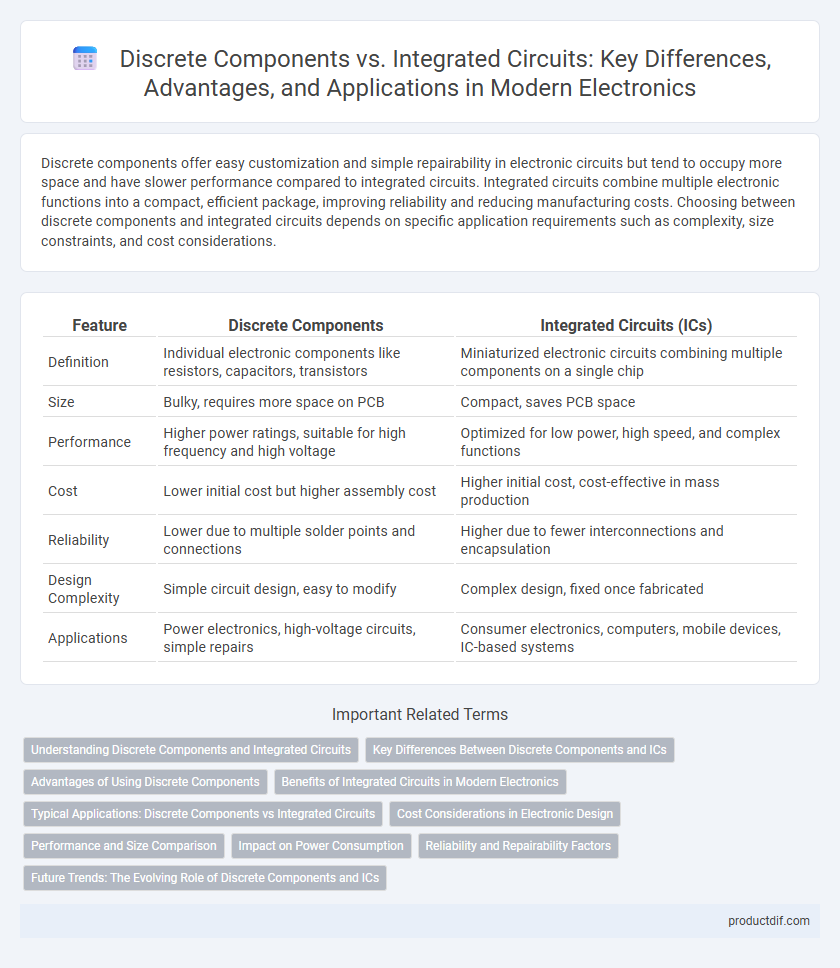Discrete components offer easy customization and simple repairability in electronic circuits but tend to occupy more space and have slower performance compared to integrated circuits. Integrated circuits combine multiple electronic functions into a compact, efficient package, improving reliability and reducing manufacturing costs. Choosing between discrete components and integrated circuits depends on specific application requirements such as complexity, size constraints, and cost considerations.
Table of Comparison
| Feature | Discrete Components | Integrated Circuits (ICs) |
|---|---|---|
| Definition | Individual electronic components like resistors, capacitors, transistors | Miniaturized electronic circuits combining multiple components on a single chip |
| Size | Bulky, requires more space on PCB | Compact, saves PCB space |
| Performance | Higher power ratings, suitable for high frequency and high voltage | Optimized for low power, high speed, and complex functions |
| Cost | Lower initial cost but higher assembly cost | Higher initial cost, cost-effective in mass production |
| Reliability | Lower due to multiple solder points and connections | Higher due to fewer interconnections and encapsulation |
| Design Complexity | Simple circuit design, easy to modify | Complex design, fixed once fabricated |
| Applications | Power electronics, high-voltage circuits, simple repairs | Consumer electronics, computers, mobile devices, IC-based systems |
Understanding Discrete Components and Integrated Circuits
Discrete components, such as resistors, capacitors, and transistors, are individual electronic devices with distinct functions used in circuits for precise control and customization. Integrated circuits (ICs) combine multiple discrete components into a single semiconductor chip, enabling complex functionalities with reduced size and enhanced reliability. Understanding the characteristics and applications of discrete components versus ICs is essential for designing efficient electronic systems.
Key Differences Between Discrete Components and ICs
Discrete components such as resistors, capacitors, and transistors are individual electronic elements with distinct functions, whereas integrated circuits (ICs) combine multiple components into a single semiconductor chip to perform complex operations. Discrete components offer flexibility in circuit design and are easier to troubleshoot, while ICs provide higher reliability, reduced size, and lower power consumption. The manufacturing process for ICs involves photolithography and doping techniques, enabling mass production with consistent performance, contrasting with the manual assembly of discrete components.
Advantages of Using Discrete Components
Discrete components offer superior customization and flexibility in electronic circuit design, allowing engineers to select and optimize individual parts such as resistors, capacitors, and transistors to meet specific performance requirements. They provide enhanced thermal management and easier troubleshooting since each component is physically separate and accessible. Furthermore, discrete components often exhibit higher power handling capabilities and can be replaced or upgraded individually, extending the lifespan and adaptability of electronic systems.
Benefits of Integrated Circuits in Modern Electronics
Integrated circuits offer significant advantages in modern electronics through miniaturization, enabling complex functionalities within compact sizes, which reduces overall device weight and power consumption. These components enhance reliability by minimizing connection points and susceptibility to mechanical failures compared to discrete component assemblies. Manufacturing efficiencies and cost reductions arise from mass production capabilities, supporting high-volume electronics industries and enabling advanced technological innovations.
Typical Applications: Discrete Components vs Integrated Circuits
Discrete components are commonly used in high-power applications, custom circuits, and situations requiring precise tuning, such as RF amplifiers and power supply regulators. Integrated circuits dominate in compact, high-density applications like microprocessors, memory devices, and consumer electronics due to their miniaturization and cost efficiency. The choice between discrete components and integrated circuits depends on factors like performance requirements, space constraints, and production volume.
Cost Considerations in Electronic Design
Discrete components often incur higher costs due to increased assembly time, larger PCB space requirements, and higher material usage compared to integrated circuits (ICs). Integrated circuits reduce overall expenses through miniaturization, enhanced reliability, and streamlined manufacturing processes, lowering labor and production costs. Cost considerations in electronic design prioritize ICs for mass production while discrete components remain viable for low-volume or highly specialized applications.
Performance and Size Comparison
Discrete components typically offer higher performance in high-frequency or high-power applications due to individual optimization but occupy more physical space on a circuit board. Integrated circuits (ICs) significantly reduce size by miniaturizing multiple functions into a single chip, enhancing compactness and reducing parasitic effects that improve overall efficiency. The trade-off favors ICs in consumer electronics for space-saving and cost-efficiency, while discrete components remain preferred for specialized, high-performance tasks.
Impact on Power Consumption
Discrete components often consume more power due to higher parasitic losses and less efficient signal paths compared to integrated circuits. Integrated circuits minimize power consumption by reducing interconnect lengths and optimizing transistor geometry at the silicon level. Advances in CMOS technology enable ICs to achieve significantly lower power dissipation in complex electronic systems.
Reliability and Repairability Factors
Discrete components offer higher repairability since individual parts can be easily replaced or tested, enhancing maintenance efficiency in electronic systems. Integrated circuits (ICs) provide superior reliability due to fewer interconnections and miniaturized structures, reducing failure rates in complex applications. However, the monolithic nature of ICs limits repair options, often requiring entire chip replacement, impacting long-term serviceability compared to discrete component assemblies.
Future Trends: The Evolving Role of Discrete Components and ICs
Future trends in electronics indicate that integrated circuits (ICs) will continue to dominate due to their miniaturization, enhanced performance, and cost-effectiveness. However, discrete components will maintain critical roles in high-power, high-frequency, and specialized applications where customization and thermal management are essential. Emerging technologies such as flexible electronics and IoT devices drive innovations that blend discrete components with ICs for optimized functionality and reliability.
Discrete Components vs Integrated Circuits Infographic

 productdif.com
productdif.com